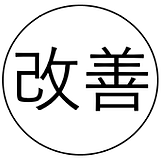Chowa
Continuous Improvement as a Marker of Success
The concept of the “company man” or “guy in the gray flannel suit” is an old-timey phrase to describe the employee who is hired, does the same thing for 25+ years, and then retires with the “gold watch” and thanks of their employer. They never change, never advance.
While this might be comfortable, it’s the picture of stagnation. Since Toyota coined the term “Kaizen,” the concept of continuous improvement has become an important measure of success for individuals and organizations, including at Inedo.
This piece is part of our Chōwa blog series.

What is Kaizen?
Over three decades ago, Kaizen or “continuous improvement” was introduced into the lexicon and was popularized by Toyota.
Kaizen is the core of Lean and Agile business and is the idea that positive yields come from ongoing, incremental changes made by all employees at every level of the organization. These changes can be as simple as changing to a mechanical pencil from a wooden one: employees may only save a few minutes a year, but those minutes are now available for other ideas and tasks.
Kaizen is a cultural mindset. It requires organizational leadership to create a company culture of Anzen, or safety, which encourages employees to suggest and implement improvements without fear of reprimand. It also requires some form of change control: Making changes higgedly piggedly and without any documentation makes it hard to identify beneficial changes that should be kept and replicated and changes that should be abandoned.
The Benefits of Continuous Improvement
The beauty of Kaizen is its simplicity: Change is a big to-do for organizations that don’t subscribe to Kaizen. A former employer of mine was a large enterprise, and onboarding a new type of software for end-user interface took three years of negotiation and 15 months to fully onboard. This change was a true nightmare to endure. Not a simple solution to the many problems it intended to address.
Big changes are unavoidable. But a company culture that encourages, supports, and celebrates small improvements with small yields will eventually see big returns.
Here at Inedo, our conference representatives saved Inedo at least two working hours per conference by optimizing the way they packed conference materials into their shipping boxes. I recently swapped our staffed chat window over to an automated chat flow to speed up conversations for both Inedo staff and our site visitors. We switched to “auto-order” for office supplies, eliminating the time spent on reordering in-demand products.
All of these might be trivial, but that’s the point. Kaizen is about always finding little ways to push yourself, your team, and your organization to be more effective and efficient. From an organizational standpoint, employee efforts toward Kaizen should be considered a marker of Seikō (success).
Get the Chōwa Book
Taikyoku is just one of the many elements of Inedo’s new cultural philosophy of Chōwa, or “natural balance.” We will be explaining the various elements of Chōwa here on our blog and on our social media (Twitter, Instagram, and LinkedIn). Subscribe to these channels and download your copy today to learn about Inedo’s unique cultural philosophy of Chōwa.
